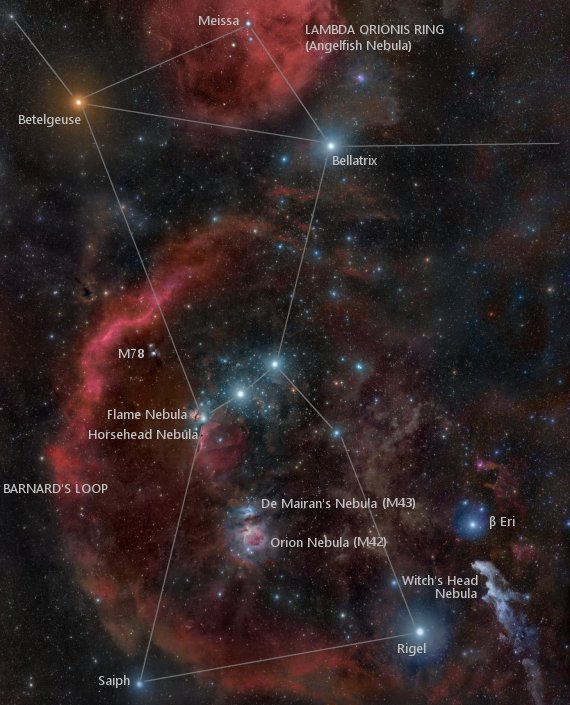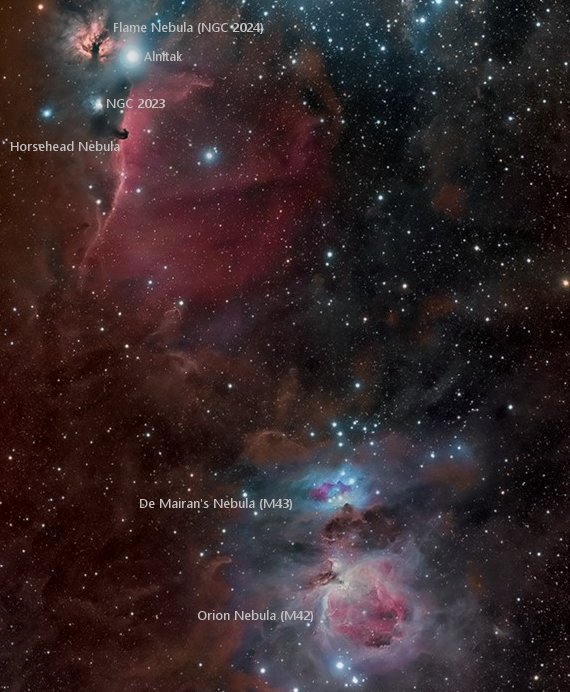Orion, the Hunter (Ori)
(oh-RYE-un)
The Northern constellation of Orion, the Hunter, is best viewed in Winter during the month of January.
Orion is the 26th largest constellation. It's brightest star is Rigel at magnitude 0.12. The boundary of the Orion constellation contains 12 stars that host known exoplanets.
Orion is an equatorial constellation, which means its bulk intersects the celestial equator or comes within 10-15 degrees of doing so. Orion is visible from most places on Earth.
- Pronunciation:
- oh-RYE-un
- Meaning:
- Hunter
- Genitive:
- Orionis
- Abbreviation:
- Ori
- Asterism:
- Belt of Orion
- Constellation Family:
- Orion
- Hemisphere:
- Northern
- Quadrant:
- NQ1
- Visibility:
- 85° N - 75° S
- Best viewing month*:
- January
- Area:
- 594 sq. degrees
- Size:
- 26th largest
- Equatorial:
- Yes
- Right Ascension (avg):
- 5h 34m
- Declination (avg):
- 4°
- Brightest star:
- Rigel (0.12)
- Stars with planets:
- 12
- X-ray stars:
- 2 (binary) stars
- Caldwell objects:
- |
Brightest Stars in Orion
The 10 brightest stars in the constellation Orion by magnitude.
- Star
- Magnitude
- Spectral class
- Beta Orionis (β Ori)
- 0.18
- B8Ia + B9V + B9V
- Alpha Orionis (α Ori)
- 0.42
- M2Ib
- Gamma Orionis (γ Ori)
- 1.64
- B2III
- Epsilon Orionis (ε Ori)
- 1.69
- B0Ia
- Zeta Orionis (ζ Ori)
- 1.88
- O9.7Ib
- Kappa Orionis (κ Ori)
- 2.07
- B0.5Ia
- Delta Orionis (δ Ori)
- 2.2
- B0III+O9V
- Iota Orionis (ι Ori)
- 2.75
- O9III
- Pi Orionis (π3 Ori)
- 3.19
- F6V
- Eta Orionis (η Ori)
- 3.35
- B1V + B2
Double Stars in Orion
These are the brightest and easiest-to-find double, triple, and quadruple star systems in the constellation Orion. Also see all star clusters.
- Star system
- Magnitudes
- Type
- Beta Orionis
- 0.3, 6.8
- double
- Delta Orionis
- 2.4, 6.8
- double
- Struve 747
- 4.7, 5.5
- double
- Lamda Orionis
- 3.5, 5.5
- double
- Theta 1 Orionis
- 6.6, 7.5, 5.1, 6.4
- quadruple
- Iota Orionis
- 2.8, 7.7
- double
- Theta 2 Orionis
- 5.0, 6.2
- double
- Sigma Orionis
- 3.8, 6.6, 3.8, 6.4
- quadruple
- Zeta Orionis
- 1.9, 3.7, 9.6
- double
Star Clusters in Orion
The most notable and easy-to-find star clusters in the constellation Orion . Also see all star clusters.
Nebulae in Orion
Notable and easy-to-find nebulae in the constellation Orion . Also see all nebulae.
Orion Clouds
Showing the Orion Molecular Cloud complex, including Barnard's Loop and the Lambda Orionis Ring.

Orion Sword Detail
Showing the famous nebulae located in Orion's Sword, including the Orion Nebula, De Mairan's Nebula, Witch's Head Nebula, Flame Nebula, and the Horsehead Nebula.

- Nebula name
- Catalog #
- Nebula type
- Barnard 30
- dark
- Barnard's Loop
- H II region
- De Mairanís Nebula
- M43
- H II region
- Flame Nebula
- emission
- Horsehead Nebula
- dark
- Kleinmann-Low Nebula
- H II region
- Lower's Nebula
- H II region
- Messier 78
- reflection
- McNeil's Nebula
- reflection
- Monkey Head Nebula
- H II region
- Orion Cloud Complex
- molecular cloud
- Orion Nebula
- M42
- diffuse
- Running Man Nebula
- reflection
- Lump Star
- emission
The Mighty Celestial Hunter
Orion, named after the mythical Greek hunter, is one of the most conspicuous and recognizable constellations in the night sky worldwide. Its prominent stars arranged in a pattern that resembles an hourglass, topped with a distinctive line of three stars forming Orion's "Belt," make it a universal point of interest among astronomers, both amateur and professional.
Historical Overview
Orion has been recognized across many cultures, from the Middle East and ancient Greece to the indigenous peoples of the Americas. The constellation is most famously associated with the Greek myth of Orion, a skilled and boastful hunter punished by the goddess Artemis, only to be immortalized in the night sky by Zeus.
Location and Main Features
Orion is located on the celestial equator, visible in both the northern and southern hemispheres, and is surrounded by notable constellations such as Taurus to the northwest, Eridanus to the southwest, Lepus to the south, and Gemini to the northeast. With an area of 594 square degrees, Orion is the 26th largest constellation in the sky.
Main Stars in Orion
The constellation is renowned for its bright stars, including Rigel and Betelgeuse. Rigel, or Beta Orionis, is a blue-white supergiant star, the sixth brightest in the sky with an apparent magnitude of 0.13. Betelgeuse, or Alpha Orionis, is a red supergiant with an apparent magnitude varying between 0.0 and 1.3, making it one of the top twenty brightest stars in the night sky.
The three stars forming Orion's Belt, Alnitak, Alnilam, and Mintaka, are another well-recognized feature of this constellation. The Belt points towards the brightest star in the night sky, Sirius, found in the Canis Major constellation.
Deep Sky Objects
Orion hosts a significant number of nebulae, clusters, and other fascinating deep-sky objects. The most notable of these is the Orion Nebula (Messier 42), an emission nebula and one of the most scrutinized and photographed objects in the night sky. This nebula, located just south of Orion's Belt, appears as a fuzzy patch to the naked eye and is visible even from areas with considerable light pollution.
Observation
Orion's celestial position allows it to be seen in many parts of the world from late autumn to early spring. Its most notable features, like Orion's Belt and the Orion Nebula, can be seen with the naked eye, but a small telescope or binoculars can reveal even more, such as the multiple star systems within the constellation and the intricate details of the Orion Nebula.
The constellation of Orion is not just an assembly of brilliant stars forming a distinctive pattern in the sky; it's a celestial theater showcasing some of the most fascinating astronomical phenomena, from the life cycle of stars observed in the contrasting fates of Rigel and Betelgeuse to the active star-forming regions in the Orion Nebula. This rich tapestry of cosmic wonders has made Orion a timeless symbol in our stargazing journey, enriching our understanding of the universe and our place within it.
* Constellation shown for northen hemisphere skies. For the southern hemisphere, constellations appear rotated 180 degrees (upside-down and left-right reversed) from what is shown. Remember that seasons are reversed too - summer in northern latitudes is winter in southern latitudes.
** Circumpolar constellations are visible year-round in the hemisphere listed (and not at all in the opposite hemisphere).





